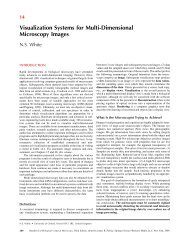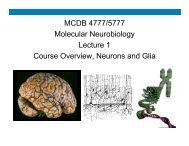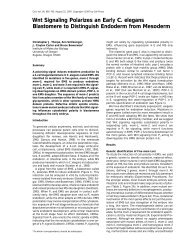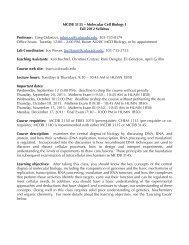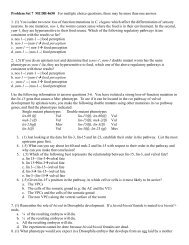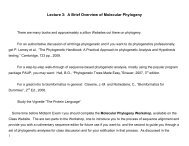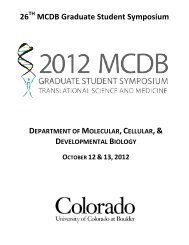Lecture 2: Describing Microbial Diversity: the ... - MCD Biology
Lecture 2: Describing Microbial Diversity: the ... - MCD Biology
Lecture 2: Describing Microbial Diversity: the ... - MCD Biology
You also want an ePaper? Increase the reach of your titles
YUMPU automatically turns print PDFs into web optimized ePapers that Google loves.
35<br />
$ Firmicutes (aka “Low G + C Gram Positive bacteria” [Bacillus, Clostridium,<br />
Streptococcus, Staphylococcus, Lactobacillus)])<br />
$ Actinobacteria (aka “High G + C Gram Positive bacteria” [Streptomyces,<br />
Mycobacterium])<br />
$ Cyanobacteria<br />
D. Note <strong>the</strong> expansion in known bacterial diversity over <strong>the</strong> past few years!<br />
16. Archaea:<br />
A. Classically two groups (Crenarchaeota and Euryarchaeota) have cultivated representatives and recognition.<br />
1) Crenarchaeota: Most cultivated types are high-temperature, but uncultivated low-temp. types are<br />
abundant in <strong>the</strong> environment (detected by cloning rRNA and o<strong>the</strong>r genes – “metagenomics”)<br />
a) Name “cren-” from <strong>the</strong> Greek for spring or fount, referring to <strong>the</strong> ostensible similarity of such organisms<br />
to <strong>the</strong> earliest life (high temperature, using geo<strong>the</strong>rmal compounds for energy, e.g. H2 / S 0 -- more later)<br />
2) Euryarchaeota: methanogens, extreme halophiles, many heterotrophs (more later):<br />
a) Name from Greek “eury-” meaning “varied”, referring to variable<br />
phenotypes, compared to cultivated crenarchaeota.





